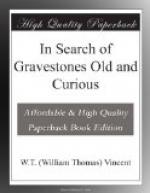No. 2 has the inscription buried, but it is of about the same date, judging by its general appearance. The strange feature in this case is the zig-zag “toothing” which is employed to represent the jaws. Doubtless the artist thought that anything he might have lost in accuracy he regained in the picturesque.
No. 3, in which part of the inscription “Here lyeth” intrudes into the arch belonging by right to the illustration, is equally primitive and artless. The eyebrows, cheeks—in fact all the features—are evidently unassisted studies from the living, not the dead, frontispiece of humanity; but what are the serifs, or projections, on either side? Wondrous as it is, there can be only one answer. They must be meant for ears! This curious effigy commemorates Mary, wife of William Greenhill, who died in 1717, aged 47 years.
No. 4 is one of the rude efforts to imitate the skull and crossbones of which we find many examples. It is dedicated to one Grinhill (probably a kinsman of the Greenhills aforesaid), who died in 1720, aged 56 years.
Most strange of all is No. 5, in which the mason leaps to the real from the emblematic, and gives us something which is evidently meant for a portrait of the departed. The stone records that Mary, wife of Thomas Jackson, died in 1730, aged 43 years. It is one of the double tombstones frequently met with in Kent and some other counties. The second half, which is headed by a picture of two united hearts, records that the widower Thomas Jackson followed his spouse in 1748, aged 55 years.
Upon a stone adjacent, to Mary London, who died in 1731, there has been another portrait of a lady with braided hair, but time has almost obliterated it. I mention the circumstance to shew that this special department of obituary masonry, as all others, was prone to imitations. I may also remark that intelligent inhabitants and constant frequenters of these two churchyards have informed me that in all the hundreds of times of passing these stones they never observed any of their peculiarities. It ought, however, to be said that these primitive carvings or scratchings are not often conspicuous, and generally require some seeking. They are always on a small scale of drawing, in nearly every instance within the diminished curve of the most antiquated form of headstone (such as is shewn in the Frontispiece), and as a rule they are overgrown with lichen, which has to be rubbed off before the lines are visible. It may safely be averred, on the other hand, that the majority of the old stones when found of this shape contain or have contained these remarkable figures, and in some places, particularly in Kent, they literally swarm. There is a numerous assortment of them at Meopham, a once remote hamlet, now a station on the London, Chatham, and Dover Railway. I have copied only one—an early attempt apparently to produce a cherub resting with outstretched wings upon a cloud, but there are a good many of the same order to keep it in countenance.




